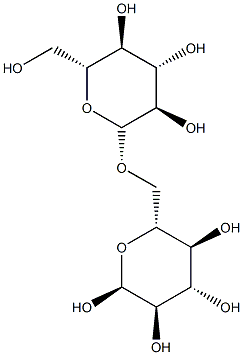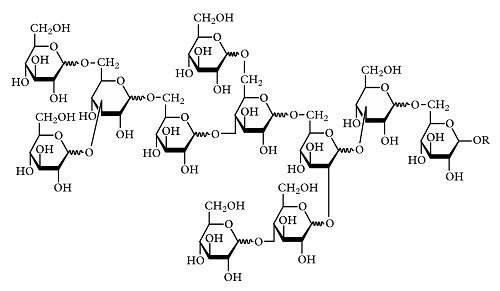
Polydextrose
- русский язык имя
- английское имяPolydextrose
- CAS №68424-04-4
- CBNumberCB7353572
- ФормулаC12H22O11
- мольный вес342.29648
- EINECS614-467-9
- номер MDLMFCD00804499
- файл Mol68424-04-4.mol
химическое свойство
| Температура плавления | >130° |
| температура хранения | 4°C, Hygroscopic |
| растворимость | Completely miscible in water. Sparingly soluble to insoluble in most organic solvents. Polydextrose has a higher water solubility than most carbohydrates and polyols, allowing the preparation of 80% w/w solutions at 20°C. Polydextrose is soluble in ethanol and only partially soluble in glycerin and propylene glycol. |
| форма | Solid |
| цвет | White to Off-White |
| Запах | at 100.00 %. odorless |
| Odor Type | odorless |
| Стабильность | Hygroscopic |
| FDA 21 CFR | 172.841 |
| Вещества, добавляемые в пищу (ранее EAFUS) | POLYDEXTROSE |
| Рейтинг продуктов питания EWG | 1 |
| FDA UNII | VH2XOU12IE |
| UNSPSC Code | 41116107 |
| NACRES | NA.24 |
Polydextrose химические свойства, назначение, производство
Химические свойства
Polydextrose occurs as an odorless, off-white to light tan powder with a bland, slightly sweet to slightly tart taste, dependent upon grade. Polydextrose is also available as a clear, light yellow to colorless liquid (70% dry substance), which is odorless with a slightly sweet taste.История
Polydextrose (PDX) was invented at Pfizer Central Research during the late 1960s, and patented in 1973 (Rennhard 1973). It was originally developed as a reduced calorie (1· kcal/g) replacement for sugar, and partial replacer for fat, fl our and starch. PDX is prepared by vacuum thermal polymerisation of glucose, using sorbitol and an approved food acid as catalyst. Random polymerisation and branching yield various types of glycosidic bonds in the structure (1,6 bonds predominate) (Rennhard 1973; Allingham 1982). A representative structure is shown in Fig. 43.1. Improved versions of PDX (Litesse®) have been patented that utilise ion exchange and hydrogenation, and provide even broader utility in foods (Borden et al. 1997; Guzek et al. 1997a, b).
The structural compactness and complexity of PDX prevents mammalian enzymes from hydrolysing the molecule. This imparts reduced caloric content, as the majority of PDX passes through the stomach and enters the large intestine, whereupon it behaves as a dietary fi bre (Craig et al. 1998). This chapter discusses the physiological benefi ts and analytical measurement of PDX.
Использование
Polydextrose is a bulking agent that is a randomly bonded conden- sation polymer of dextrose containing small amounts of bound sor- bitol and citric acid. it is a water-soluble powder providing a ph range of 2.5–3.5. it is partially metabolized which results in a caloric value of 1 cal/g. as a reduced-calorie bulking agent, it can partially replace sugars and in some cases fats in reduced-calorie foods. it also functions as a bodying agent and humectant. applications include desserts, specific baked goods, frozen dairy desserts, chewing gum, and candy. usage levels vary according to application, but examples are frozen dessert, 13–14%; puddings, 8–9%; and cake, 15–16%.Методы производства
Polydextrose is prepared by the bulk melt polycondensation of glucose and sorbitol in conjunction with small amounts of foodgrade acid in vacuo. Further purification steps are then involved to generate a range of products with improved organoleptic properties by the removal of acidity and flavor notes generated during the condensation reaction. A partially hydrogenated version of polydextrose, which is suited for high inclusion rates, for sugar-free applications, and where Maillard reactions are not required, is also available.Фармацевтические приложения
Polydextrose is used in pharmaceutical formulations and food products. In food products it is used as a bulking agent; it also has texturizing and humectant properties. Although polydextrose can be used in a wide range of pharmaceutical formulations, its primary use is in solid-dosage forms.In tableting, polydextrose solutions are used as binders in wetgranulation processes. Polydextrose is also used in the manufacture of directly compressible tableting excipients. Polydextrose solutions may also be used, in conjunction with other materials, as a film and tablet coating agent.
Polydextrose acts as a bulking agent in the formulation of ‘sugarfree’ confectionery-type dosage forms. In conjunction with isomalt, lactitol, or maltitol, polydextrose can be used in the manufacture of ‘sugar-free’ hard-boiled candies and acacia lozenges or pastilles as a base for medicated confectionery.
The combination of high water solubility and high viscosity of polydextrose facilitates the processing of sugar-free candies of excellent quality. Polydextrose is amorphous and does not crystallize at low temperatures or high concentrations, so it can be used to control the crystallization of polyols and sugars and therefore the structure and texture of the final product.
Побочные эффекты
Polydextrose is POSSIBLY SAFE when taken by mouth in doses of less than 50 grams per day. Polydextrose can cause intestinal gas (flatulence), bloating, stomach cramps, and diarrhea. Polydextrose is POSSIBLY UNSAFE when taken by mouth in single doses of more than 50 grams or in daily doses of more than 90 grams.Безопасность
Polydextrose is used in oral pharmaceutical applications, food products, and confectionery, and is generally regarded as a relatively nontoxic and nonirritant material.However, excessive consumption of non-digestible carbohydrates, such as polydextrose, can lead to gastrointestinal distress. After evaluating a series of clinical studies, the Joint FAO/WHO Expert Committee on Food Additives (JECFA) and the European Commission Scientific Committee for Food (EC/SCF) concluded that polydextrose was better tolerated than other digestible carbohydrates such as polyols. The committee concluded that polydextrose has a mean laxative threshold of approximately 90g/day (1.3 g/kg body-weight) or 50g as a single dose.
(mouse, oral): >30 g/kg
(rat, oral): >15 g/kg
хранилище
Polydextrose powder is hygroscopic and absorbs significant amounts of moisture at relative humidities greater than 60%. Under dry storage conditions, and in original sealed packaging, polydextrose powders can be expected to retain stability for at least 3 years. Solution grades have a shorter shelf-life of 3 to 6 months (dependent upon grade) at an ambient temperature of 25°C, although this can be extended to 12 months through the use of refrigeration.The bulk material should be stored in a cool, dry place in wellclosed containers.
Несовместимости
Incompatible with oxidizing agents, strong acids, and alkalis, forming a brown coloration and depolymerizing.Регуляторный статус
Approved as a food additive in over 60 countries worldwide, including Europe and the USA. Included in the FDA Inactive Ingredients Database (oral tablets). Included in non-parenteral medicines licensed in the UK. Included in the Canadian List of Acceptable Non-medicinal Ingredients.Polydextrose запасные части и сырье
Polydextrose поставщик
| поставщик | телефон | страна | номенклатура продукции | благоприятные условия | |
|---|---|---|---|---|---|
| +86-0551-65418679 +8618949832763 |
China | 2986 | 55 | ||
| +8613031735486 | China | 105 | 58 | ||
| +86 13288715578 +8613288715578 |
China | 12825 | 58 | ||
| +86-13131129325 | China | 5887 | 58 | ||
| +86-15532196582 +86-15373005021 |
China | 3007 | 58 | ||
| +86-371-86557731 +86-13613820652 |
China | 20259 | 58 | ||
| +8618092446649 | China | 1143 | 58 | ||
| +8613343047651 | China | 3692 | 58 | ||
| +86-17332992504 +86-17332992504 |
China | 300 | 58 | ||
| +86-(0)57185586718 +86-13336195806 |
China | 29792 | 60 |